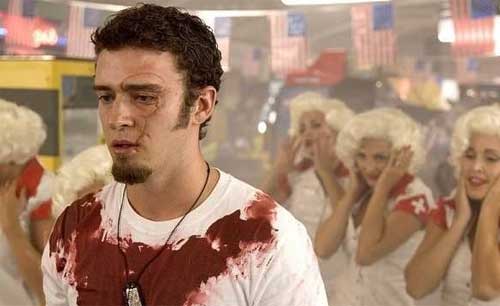Title: Leviathan
Director: George P.
Cosmatos
Released: 1989
Starring: Peter
Weller, Richard Crenna, Amanda Pays, Daniel Stern, Ernie Hudson,
Michael Carmine, Lisa Eilbacher, Hector Elizondo
Plot: A group of
deepsea miners discover a Soviet shipwreck, Leviathan only to bring
back with their salvage an entity which soon begins working its way
through the crew.
Review: One of a slew of Underwater Sci-fi horror released in the wake of The
Abyss alongside Deep Star Six a film which proved as tricky to get hold
of. Unlike Deep Star Six this one actually proved to be worth the
effort as it plays like a more horror focused version of The Abyss with a
dash of John Carpenter’s The Thing thrown in for good measure.
Directed by George P. Cosmatos whoat this point was coming into the film hot after directing both Rambo: First Blood 2 and Cobra; here though he calms things back alittle as he introduces a crew of blue collar deep sea miners headed up by geologist Steve Beck (Weller) who like the rest of the crew is looking forward to the shift change in 4 days. However the chance discovery of the scuttled Soviet ship soon brings with it all kinds of problems when the experiment which was being tested on the unknowing crew is soon wreaking havoc on the mining team.
Despite the B-movie roots of the film each of the crew are given enough depth to help them standout more than disposable monster chow, though at the same time most of the crew for the first quarter are overshadowed by the pervert antics of Six Pack played here by Daniel Stern who spends most of his time in the film trying to hit on or just straight up sexually harass the two female crew members which is the kind of thing that you could never get away with now, especially with his boob mug and the centrefolds he plasters across his bunk. The crew in general though are a likeable bunch with Ernie Hudson getting a few great lines while Weller is enjoyable as the lead his performance remains as diversive as ever especially in the first quarter were he seems to actually be confused about what he’s supposed to be going while his payoff line of “Open wide Motherfucker!!” comes off a little more amusing than I think it was originally planned.
Shot on sound stages in Rome the layout of the Miner’s “Shack” is actually very similar to the Deep Core research station of The Abyss in that everything is raw steel and exposed pipes but at the same time we see throughout this station subtle details such as the screens playing footage of landscapes and sunlamps to strive away the effects of being underwater for long periods. Such a functional setup of course only works the better during the final were the high pressure of the surrounding ocean slowly crushes the station causing the internal structure to collapse and spectacularly implode. At the same time the lack of sterile work areas and clunky diving suits designed to deal with the high pressure really give the film a presence and memorable look which complements this crew of blue collar workers, striving off the boredom and cablin fever of their surroundings till the next shift change.
While the monster action is alittle slower than expected to start as what initially starts out seemingly as an infection after two of the miners consume vodka they fund amongst their salvage from the ship and because seemingly no one told this pair about why you don’t drink things you find on sunk ships the film soon mutates into body horror before the film just turns into a full blown monster on the loose movie. Much like as in Alien though the crew also have to deal with the shady plots of the company higher ups here represented by an almost otherworldly Meg Foster who communicates with Beck via the station video monitor, though it’s soon becomes clear that they might be working their own agenda as always seems to be the case in these movies.
With Stan Winston handling the creature effects they still look impressive if never going as crazy as Rob Bottin’s effects for The Thing. However watching the film now it doesn’t really matter as with these kind of movies now just being the preferred output of the Asylum and the SYFY channel to actually have a half decent film with practical effects leaves you feeling kind spoiled to not be subjected to subpar CGI. At the same time the monster does have a few unique quirks of it’s own as we see crew members absorbed into it’s skin adding a nice moral quandry for those attempting to fight it as they are faced with the prospect of having to kill their friends in order to kill the monster.
A fun throw back which serves as a reminder as to how far this sub-genre has fallen and while it might not reach the same heights as The Abyss it’s a notable step up from Deep Star Six and perhaps if the tension was built upon more it might be more fondly remembered. Regardless there is still plenty for genre fans to enjoy here.






























